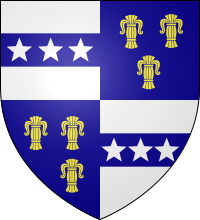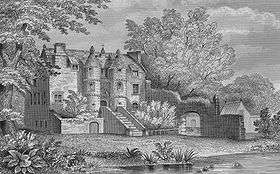Clan Muir
Clan Muir is a Scottish clan that is armigerous (it has no chief recognized by the Court of the Lord Lyon).[1] Historically, holders of the surname Muir (also spelt Moir, Moor, Moore, More, and Mure) can be considered septs of Clan Campbell[2] and septs of Clan Gordon in the highlands.[3] The spelling variation More/Moore is a sept of Clan Leslie in Aberdeenshire.[4] Some members of Clan Muir who trace their ancestry to Ayrshire are septs of Clan Boyd.[5] A single family, the Mores/Moores of Drumcork, are septs of Clan Grant.[6]
| Clan Muir | |
|---|---|
 Crest: A savage head couped Proper | |
| Motto | Durum patientia frango |
| Profile | |
| Region | Lowlands |
| District | East Ayrshire |
 | |
| Clan Muir has no chief, and is an armigerous clan | |
| Historic seat | Rowallan Castle |
Origins and history
The Scottish surname Muir originated as name denoting someone who lived beside a moor. The name is derived from the Scots form of the Middle English more, meaning "moor" or "fen".[7][8] The name may alternately derive from the Scottish Gaelic word muir, meaning sea, or mòr meaning of great size, tall and important, as in duine mòr, a great man or considerable personage.[9]
Mures of Rowallan
The family is said to have come from Ireland. Polkelly seems to have been the most ancient property held in Scotland by the Mures. An Archibald Mure was slain at Berwick in 1296 when Balliol's army was routed.[10]
The Mures were prominent figures throughout the history of Scotland, from Sir Gilchrist Mure, who married the daughter and sole heir of Sir Walter Comyn with the blessing of King Alexander III, for his part in the battle of Largs.[11] This secured the family seat at Rowallan Castle. Another version states that Gilchrist Mure was dispossessed of the house and living at Rowallan by the strong hand of Sir Walter Cuming, and was compelled to keep close in his castle of Polkelly until Alexander III raised sufficient forces to subdue Cuming and his adherents. The family had held Rowallan, in this version, from unknown antiquity.[12]

The conjoined arms of the first Muir of Rowallan were visible on the oldest part of the castle up until the 18th century.[11] Elizabeth Mure,[14] daughter of Sir Adam Mure of Rowallan and Jannet Mure, was mistress to Robert Stewart (who later became Robert II of Scotland in 1371).[15] Later on 22 November 1347 she married him by Papal dispensation to legitimize their previously born children.[15] After their legal marriage, Elizabeth Mure was styled Countess of Atholl, and her surname became Stewart. Elizabeth died sometime before 1355.[15]
Sir Gilchrist Muir built two chapels, one at the Well named for Saint Laurence and the other at Banked named for Saint Michael. The vestiges of these were still visible in 1876. He also built the chapel of Kilmarnock, commonly called Muir's Isle (sic).[16]
One of the Sir Robert Mures was slain at the Battle of Sark. His namesake was called the Rud of Rowallane, being large in stature, very strong and prone to pugilism; these characteristics neatly define the meaning of this archaic Scots word. He wasted his inheritance and during his lifetime a protracted feud took place with the house of Ardoch (Craufurdland) which resulted in much bloodshed. The 'Rud' resigned his lands in favour of his grandson John, who married Margaret Boyd a mistress of James IV.[17]
Campbells, Lairds of Rowallan

Sir William Mure was the sixteenth and last Mure of Rowallan. He served in Germany under Gustavus Adolphus. One of his grand-daughters married Sir James Campbell of Lawers, third son of the Earl of Loudoun, who thus became Laird of Rowallan. His son, Major-General James Mure Campbell of Rowallan (1726–86), became the fifth Earl of Loudoun in 1782. His only daughter's great-grandson, Charles Rawdon-Hastings, 11th Earl of Loudoun succeeded in 1874 and held the lands of Rowallan as Laird.[11]
Clan motto
- Motto - Durum Patientia Frango (By patience I break what is hard).[18]
Associated names
Clan Muir does not have any septs, though common variations of the name Muir or Moore are associated with the clan.
- Muir/More/Moore/Mure - more common in Ayrshire and areas in the Southwest lowlands[19]
- Moar/Moare/Moer - more common in Orkney and Shetland [19]
- Moir/Moire - more common in Aberdeenshire and areas in the Southeast lowlands [19]
- Mohr/Mor - more common in the Central lowlands [19]
- Moor/Mur
- Mour/Moure
- Myre/Myres
- Langmoore/Longmuir
- O'More/O'Morhda/O'Moore - more common in Ireland [19]
- Moore/Morey - more common in Ireland
- de Mora - more common in Ireland
Clan affiliation by spelling variation
- Muir/Mure/Moore - more common in Clan Campbell
- Moir/Moire - more common in Clan Gordon
- Moore - more common in Clan Leslie
- Moore/More - more common in Clan Grant
- Langmoore/Longmuir - more common in Clan Boyd
Clan membership
Clan membership is determined by surname. According to Sir Crispin Agnew of Lochnaw, if a person has a particular sept name which can be attributed to a number of clans, either they should determine from which part of Scotland their family originally came from and owe allegiance to the clan of that area or, alternatively, if they do not know where they came from, they should owe allegiance to the clan to which their family had traditionally owed allegiance. Alternatively, they may offer allegiance to any of the particular named clans in the hope that the Chief will accept them as a member of his clan. Thus if a person offers his allegiance to a particular Chief by joining his clan society or by wearing his tartan, he can be deemed to have elected to join that particular clan and should be viewed as a member of that clan.[20] Members of Clan Muir who do not give their allegiance to any of the clans that list their surname as a sept or who do not have a family history of belonging to any of the aforementioned clans wear the Muir tartan.
References
- "Official Scottish Clans and Families". Electricscotland.com. 28 August 2002. Retrieved 28 October 2011.
- "Septs of Clan Campbell". Ccsna.org. Retrieved 28 October 2011.
- Lois M Todd/House of Gordon USA. "House Of Gordon USA About Us". Houseofgordonusa.org. Retrieved 28 October 2011.
- "index". Clanlesliesociety.org. Retrieved 28 October 2011.
- "Septs of Boyd Clan". Clanboyd.org. Archived from the original on 4 October 2011. Retrieved 28 October 2011.
- "Septs". Clangrant.org. Archived from the original on 7 April 2003. Retrieved 28 October 2011.
- "Learn about the family history of your surname". Ancestry.com. Retrieved 24 October 2011.. This website cited: Dictionary of American Family Names, Oxford University Press, ISBN 0-19-508137-4
- Black, George Fraser (1946), The Surnames of Scotland: Their Origin, Meaning, and History, New York: New York Public Library, p. 617
- MacLennan, Malcolm (1991), A Pronouncing and Etymological Dictionary of the Gaelic Language, Stornoway: Acair and Aberdeen University Press, ISBN 0-08-025713-5
- Paterson, James (1866), History of the Counties of Ayr and Wigton. Pub. James Stillie, Edinburgh. Vol.III. P. 437 - 447.
- Miller, A. H. (1885). The Castles and Mansions of Ayrshire. Reprinted by The Grimsay Press, 2004. ISBN 1-84530-019-X P. 128.
- Adamson, Archibald R. (1875), Rambles Round Kilmarnock. Pub. T. Stevenson, Kilmarnock. P. 144 -145.
- Dobie, James. (1876) Cuninghame Topographized by Timothy Pont. Pub. John Tweed, Glasgow. Facing P. 364.
- A painting of Elizabeth Mure
- "Person Page 10210". thePeerage.com. Retrieved 28 October 2011.
- Dobie, James (1876), Cuninghame, Topographized by Timothy Pont. Pub. John Tweed. Glasgow. P. 399.
- Adamson, Archibald R. (1875), Rambles Round Kilmarnock. Pub. T. Stevenson, Kilmarnock. P. 146.
- Dobie, James. (1876) Cuninghame Topographized by Timothy Pont. Pub. John Tweed, Glasgow. Facing P. 402.
- Jann Muir (28 February 2008). "Clann Muir WorldWide ~ Durum Patientia Franco". Clannmuir.com. Archived from the original on 15 October 2011. Retrieved 28 October 2011.
- "Clans, Families and Septs". Electricscotland.com. 13 August 2001. Retrieved 28 October 2011.